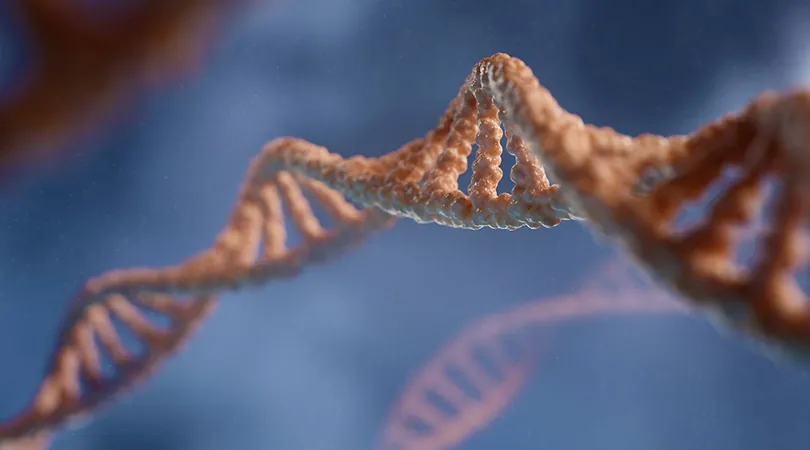
Revolutionary Insights into DNA Organization Could Change Medicine Forever!
2024-10-24
Author: Arjun
Groundbreaking Multilayer Model of Chromatin Organization
Scientists may have just unlocked the secrets to understanding the complexities of our DNA. A new study reveals a groundbreaking multilayer model that explains how chromatin— the protein-DNA complex— folds and organizes itself, potentially paving the way for significant advancements in medical science.
Imagine this: in every human cell, the DNA stretches about two meters. Yet it fits into a nucleus far smaller than a human hair. This incredible feat is accomplished when DNA wraps around proteins known as histones, forming structures called nucleosomes. Picture them as “beads on a string…” but this 'string' undergoes an elaborate process, coiling and twisting into tightly packed chromosomes— a necessity for maintaining order and accessibility for vital cellular functions like gene expression and cell division.
Challenging Existing Theories
Despite extensive research, previous models failed to accurately depict the intricacies of DNA folding. They often ignored crucial factors dictated by experimental data, which could foster a deeper understanding of heredity and how traits are expressed. Joan-Ramon Daban, a leading figure at Universitat Autònoma de Barcelona, emphasizes the importance of integrating an analytical approach to develop a comprehensive structural model of chromosomes.
Current models of chromatin, which often depict empty spaces and a lack of organization, fall short of explaining the compact and systematic ‘sardine can’ structure required to accommodate vast amounts of DNA. Daban points out that many models neglect the self-associative properties of nucleosomes and their arrangement.
To develop a realistic representation of how chromatin folds, researchers must acknowledge the dynamic nature of these structures—how they twist and bend while securing themselves from tangles or breakages, yet still allowing for the critical unwinding functions necessary for gene expression.
Through cutting-edge imaging microscopy studies in Daban's lab, researchers made a startling discovery: chromatin forms flat, stacked layers, each no thicker than a single sheet of nucleosomes. This suggests a systematic, multilayer folding pattern in chromosomes, significantly reducing the chances of entanglement— a common issue with long strands of genetic material.
Unlocking the Mysteries of Gene Regulation
Daban highlights that the multilayer organization could significantly influence epigenetic mechanisms—essentially ‘switches’ that regulate gene activity without altering the genetic code itself. These mechanisms, influenced by lifestyle and environmental factors, can be passed down through generations, highlighting the multilayer model's potential to enhance our understanding of heredity.
Most existing models struggle with certain chromosome characteristics, like the distinct light and dark bands observed under microscopes or the complex genetic rearrangements that occur. The innovative multilayer chromatin model proposed by Daban suggests that chromosomes behave similarly to liquid crystals, enabling smooth movement between layers without tangling.
While this new model is a promising step towards a fuller understanding of chromatin organization, further experimental validation is essential. If substantiated, it could transform our comprehension of important biological processes—such as gene regulation, DNA replication, and repair—heralding a new era in biomedical research.
Daban's aspiration is clear: to see the multilayer model widely accepted and featured in academic texts, revolutionizing the study of molecular biology and genetics.
Stay tuned as the implications of this research potentially open the door to groundbreaking medical therapies and innovations that could change lives for generations to come!


 Brasil (PT)
Brasil (PT)
 Canada (EN)
Canada (EN)
 Chile (ES)
Chile (ES)
 Česko (CS)
Česko (CS)
 대한민국 (KO)
대한민국 (KO)
 España (ES)
España (ES)
 France (FR)
France (FR)
 Hong Kong (EN)
Hong Kong (EN)
 Italia (IT)
Italia (IT)
 日本 (JA)
日本 (JA)
 Magyarország (HU)
Magyarország (HU)
 Norge (NO)
Norge (NO)
 Polska (PL)
Polska (PL)
 Schweiz (DE)
Schweiz (DE)
 Singapore (EN)
Singapore (EN)
 Sverige (SV)
Sverige (SV)
 Suomi (FI)
Suomi (FI)
 Türkiye (TR)
Türkiye (TR)
 الإمارات العربية المتحدة (AR)
الإمارات العربية المتحدة (AR)